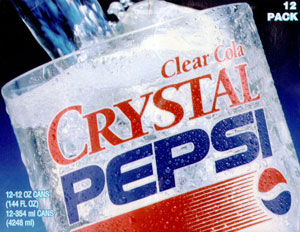Vodka and Cola

Given these failures, one would assume that these massive soft drink companies had never attempted to make a cola which wasn’t caramel colored. But well before Crystal Pepsi and Tab Clear came another different-colored cola, informally called White Coke.
In the 1940s, the Marshal of the Soviet Union (the de facto highest rank in the Soviet military), a man named Georgy Zhukov, took a liking to Coca-Cola. But Coke was symbolic of America, of capitalism, etc., and Zhukov — given his position of prominence — couldn’t be seen drinking the stuff. He, through his American counterpart General Mark W. Clark (who in turn took the question to President Truman), asked that the Coca-Cola Company develop a cola which, visually, resembled vodka. This way, as reported by the New York Times, he could be seen drinking it whenever, without risking the ire of Joseph Stalin. (Apparently, it was OK for Soviet military leaders to grab a vodka and a smile.) Coke complied.
For years, Coke provided the cola to Zhukov and somehow managed to avoid most of the red tape which defined importations into the USSR during that period. The cola was never introduced to consumers in the States.
Bonus fact: In 1990, the Mars candy company introduced PB Max, a cookie topped with peanut butter, with the whole thing covered in milk chocolate. Like Crystal Pepsi and Tab Clear, PB Max did not last very long — it was discontinued a few years later. But unlike the colas, PB Max was a commercial success. Why was it discontinued? According to an anonymous executive cited by the best-selling book “The Emperors of Chocolate,” the Mars family has a distaste for peanut butter and opted to take PB Max out of their product line, despite its additions to the family’s coffers. (This also explains why Mars’ peanut butter M&Ms, while common now, are relatively new compared to Reese’s Pieces.)
From the Archives: Cola Enforcement Agency: Coca-Cola’s cocaine problem.
Related: “For God, Country, and Coca-Cola: The Definitive History of the Great American Soft Drink and the Company That Makes It” by Mark Pendergrast. 4.5 stars on 23 reviews. Available on Kindle.

Leave a comment